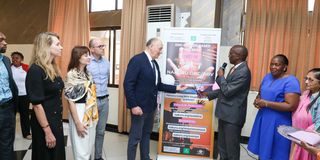Nakuru GBV system records 14 cases, as awareness grows

Nakuru County Deputy Governor David Kones (right) during the launch of the Information management System that will help in reporting and tracking GBV cases on February 27, 2025.
Nakuru County’s Gender Based Violence (GBV) reporting and tracking website has recorded 14 cases, since its launch on February 27th.
According to John Momandi, a gender officer in the county, the digital initiative is reshaping how cases of GBV are reported, tracked, and addressed, providing survivors and communities with an accessible tool for action and accountability.
“Of the 14 reported cases, eight were self-reported directly through the system,” explains Momandi. “The rest were recorded proactively by our department, often where families had not yet taken any step to report, case in point, the murder of Wanjiru Ng’ang’a from Subukia.”
Momandi notes that this entry system ensures that no case is overlooked, whether it’s reported by the victim, a Community Health Promoter (CHP), or captured through departmental follow-up.
The platform doesn’t just collect reports; it also acts as a real-time alert system. When a case is entered, the platform notifies the department instantly.
“This helps us respond quickly and verify the information. The types of cases surfacing range from defilement and assault to rape, with areas like Rongai sub-county currently showing the highest concentration of reports,” he shares.
Additionally, he notes that owing to its slow uptake, the website’s effectiveness depends on widespread training and sensitization.
He mentions that the department have started rolling out sensitization through quarterly cluster meetings across sub-counties, citing Gilgil as one of the sub-counties already engaged.
The county is also collaborating with several partner organizations to drive these awareness efforts and is planning to reach more sub-counties before the current financial year ends.
Momandi is quick to note that a key part of this awareness campaign is empowering Community Health Promoters (CHPs), who are positioned deep within communities and often closer to residents than even local chiefs.
“CHPs are equipped with smartphones and trained to record GBV cases at any time. Their involvement significantly expands the network of early reporters, helping to capture incidents that might otherwise go undocumented,” he says.
Other than that, he notes that one unique strength of the system is that it does not stop at reporting.
Progressively, each case moves through clearly defined stages, and at every step, recommendations are documented.
“We have a network of pro bono lawyers and psychosocial support specialists whom we have been able to link the victims to, allowing them to get legal help or emotional support. This we do by stepping in directly or referring them to our partners,” says Momandi.
He considers the platform to be a high-impact innovation. However, he emphasizes that the goal is not to increase the number of GBV cases, but to ensure that every incident is counted, every survivor is heard, and a stronger data-driven response can be crafted.
“The more people report, the more we understand where the problem lies and the better we can respond,” he says.

